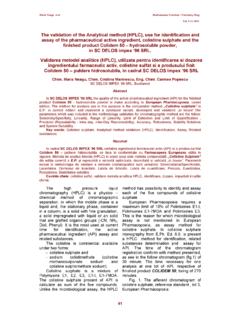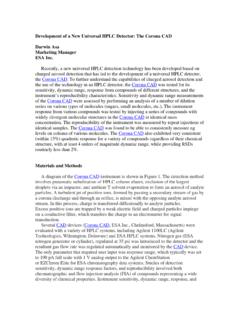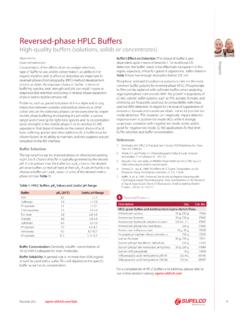Transcription of Columns for HPLCColumns for HPLC - Western …
1 Columns for HPLCC olumns for hplc 20 this chapter we describe analytical hplc Columns withour NUCLEOSIL silica phases. Silica as well as polymer-based phases for special separation problems are describedin the chapter Columns for special applications from p. our silica bulk packing materials, spherical NUCLEOSIL and NUCLEODUR materials and the irregular POLY-GOSIL and POLYGOPREP silicas, please see the chapter Packings for hplc from p. 143. NUCLEOSIL silica the standard in hplc NUCLEOSIL is a family of totally porous spherical feature a very pure and uniform SiO 2 structure andhave gained wide acceptance as outstanding chromato-graphic packing for very different fields of modern chroma-tography.
2 Due to its particle sizes NUCLEOSIL finds application in an-alytical as well as in preparative Columns . It allows high bed stability due to spherical particles high efficiency due to narrow particle size distribution high separation performance due to optimized bindingtechniques high chemical and mechanical stabilityhigh load capacity and recovery rateshigh reproducibility from lot to lotAs can be seen in the figure, NUCLEOSIL is a sphericallyshaped totally porous silica. We manufacture this packingmaterial with different pore diameters (50, 100, 120, 300,500, 1000 and 4000 ) and particle sizes from 3 m (onlyNUCLEOSIL 50, 100 and 120) to 10 m with very narrowfractionation.
3 The different groups of NUCLEOSIL packing materials andcolumns packed with these phases are described in detail inthe following chapters. All narrow-pore NUCLEOSIL packings are stable up to 600bar (8 500 psi), for NUCLEOSIL 120 even pressures of upto 800 bar (11 500 psi) can be applied. The wide-pore NU-CLEOSIL silicas are stable up to 300 or 400 bar (4 200 or5 600 psi). Thus all NUCLEOSIL packings can be used inevery field of hplc without limitations. Modified packings NUCLEOSIL packings are available as unmodified silica orwith numerous chemically bonded phases.
4 Silica packingswith chemically bonded phases can be classified in severalgroups, namely those intended mainly for reversed phasechromatography (the base deactivated RP phases C 18 AB,C 18 HD, C 8 HD, NAUTILUS and PROTECT I and the stand-ard RP phases C 18 , C 8 ec, C 8 , C 4 , C 2 and Phenyl) as well aspackings with chemically bonded polar groups with selectiveseparation performance (such as CN, NO 2 , NH 2 , N(CH 3 ) 2 ,OH types). Furthermore, for NUCLEOSIL 100 we produceion exchangers (NUCLEOSIL SA and SB), which are stablefrom pH 2 to 8,5 and do not swell.
5 Compared to resin-basedion exchangers they offer the advantage of constant permea-bility, even when the ionic strength and/or pH of the eluentare photograph of NUCLEOSIL (magnification see scale, 1 cm 40 m) NUCLEOSIL silica summary of available modifications Type of modificationfunctional grouporganic Si-C groupPore diameter [ ]Parti-cles50 10012030050010004000 base deactivated RP phases C 18 HD see p. 28 Octadecyl, base deactivatedmonomer modification -(CH 2 ) 17 -CH 3 3 m 5 m 7 m C 8 HD see p. 28 Octyl, base deactivatedmonomer modification -(CH 2 ) 7 -CH 3 3 m 5 m C 18 NAUTILUS see p.
6 30 Octadecyl, base deactivatedembedded polar groupfor up to 100% aqueous eluents 3 m 5 m PROTECT I see p. 32 special RP phasebase deactivated, monomer modification 3 m 5 m = as packed column in our standard programme; = available as bulk material Analytical Columns packed with NUCLEOSIL Columns for HPLCC olumns for hplc 21 C 18 AB see p. 34 Octadecyl, base deactivatedpolymer modification -(CH 2 ) 17 -CH 3 5 m Standard RP phases C 18 see p. 39 Octadecyl, endcapped-(CH 2 ) 17 -CH 3 3 m 5 m 7 m 10 m C 8 ec see p.
7 43 Octyl, endcapped-(CH 2 ) 7 -CH 3 5 m C 8 see p. 43 Octyl, not endcapped-(CH 2 ) 7 -CH 3 3 m 5 m 7 m 10 m C 6 H 5 ec see p. 46 Phenyl, endcapped-(CH 2 ) 3 5 m C 6 H 5 see p. 46 Phenyl-(CH 2 ) 3 5 m 7 mC4see p. 47 Butyl-(CH2)3-CH3 5 m 7 m 10 mC2see p. 48 Dimethyl-(CH3)2 7 mPolar NUCLEOSIL phases and NUCLEOSIL ion exchangersCNsee p. 51 Cyano (Nitrile)-(CH2)3-CN 5 m 7 m 10 mNO2see p. 52 Nitro-(CH2)3NO2 5 m 10 mOHsee p. 53 Diol 5 m 7 mNH2see p. 55 Amino-(CH2)3-NH2 3 m 5 m 7 m 10 mN(CH3)2see p.
8 56 Dimethylamino-(CH2)3-N(CH3)2 5 m 10 mSAsee p. 57 Sulphonic acid-(CH2)3SO3Na 5 m 10 mSBsee p. 58quaternary ammonium groups-(CH2)3CH2-N+(CH3)3Cl 5 m 10 mNUCLEOSIL silica summary of available modificationsType of modificationfunctional grouporganic Si-C groupPore diameter [ ]Parti-cles50 10012030050010004000 = as packed column in our standard programme; = available as bulk material-(CH2)3-O-CH2-CH-CH2OH OHAnalytical Columns packed with NUCLEOSIL for HPLCC olumns for deactivated phases for RP chromatographyIt is a known fact that the surface of silica contains activegroups that can cause unwanted interactions with the ana-lytes, even after derivatization and endcapping.
9 For NUCLEOSIL , MACHEREY-NAGEL use four differentapproaches to reduce silanol interactions. This results in fourtypes of base deactivated RP phases, which cover a verywide range of selectivities solving almost all reversed phaseseparation 100-5 C18 ABthe classical Acid and Base deactivated octadecyl-phasewith polymeric coatingThis phase exhibits a high steric 100-5 C8 HD NUCLEOSIL 100-3 C18 HD NUCLEOSIL 100-5 C18 HDa family of base deactivated phases with a High Densitymonomeric coatingavailable as octyl phase or octadecyl phase with 3 or 5 mparticlesThe dense coverage with alkyl groups results in phases withvery low bleeding.
10 Which are ideal for trace analyses and es-pecially recommended for 100-3 C18 NAUTILUS, NUCLEOSIL 100-5 C18 NAUTILUS base deaktivated octadecyl phases for up to 100% aque-ous eluentsAn embedded polar functional group allows chromatographyunder purely aqueous elution 100-3 PROTECT I, NUCLEOSIL 100-5 PROTECT Ia base deactivated silica RP phase with special mono-meric coatingA polar protective group in the carbon skeleton strongly inter-acts with the silanol groups, effectively shielding them fromthe featuring an outstanding base deactivation, the phaseNUCLEOSIL PROTECT I shows higher hydrophilicity thanthe above (CH3)3 SiOHconventional NUCLEOSIL 100-5 C18 SiOSi(CH3)3 PolPolSiOHSiOSi(CH3)3 SiOHproproAnalytical Columns packed with NUCLEOSIL for HPLCC olumns for deactivated phases for RP chromatographyWhy is a good base deactivation of the silica so important?










